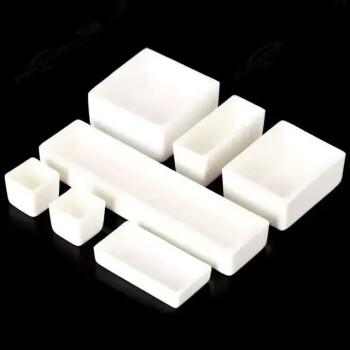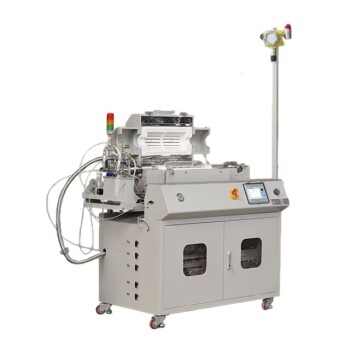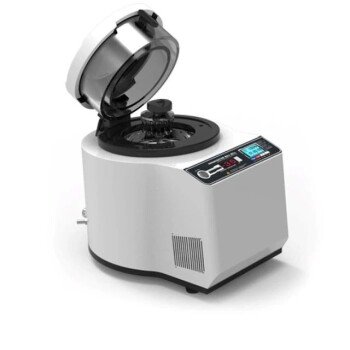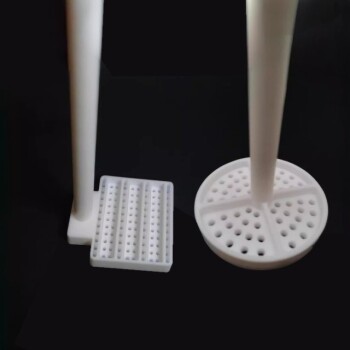In short, they are the linchpin of the entire distribution strategy. Ultra-low temperature (ULT) freezers provide the extremely cold and stable environment, typically -80°C (-112°F), required to store messenger RNA (mRNA) vaccines for COVID-19. This extreme cold is essential to prevent the fragile mRNA molecules from degrading, which would render the vaccine ineffective.
Ultra-low temperature freezers are not merely cold boxes; they are precision instruments that create an environment to effectively pause molecular activity. This capability was the foundational technology that made the global distribution of novel mRNA vaccines possible by preserving their delicate genetic instructions.

Why mRNA Vaccines Demand Extreme Cold
To understand the role of ULT freezers, you must first understand the nature of mRNA itself. It is a fundamentally unstable molecule designed by nature for temporary work.
The Fragility of Messenger RNA (mRNA)
Messenger RNA is a single-stranded molecule that carries genetic instructions from a cell's DNA to its protein-making machinery. Unlike the robust double-helix of DNA, mRNA is designed to be short-lived and is quickly broken down by common enzymes. This inherent fragility is its greatest vulnerability outside of a living cell.
Preventing Molecular Degradation
When the mRNA in a vaccine breaks apart, its instructions become corrupted and unreadable. This process, known as degradation, makes the vaccine useless. The primary goal of vaccine storage is to halt this degradation process entirely.
The Role of Temperature in Preservation
Extreme cold is the most effective way to preserve mRNA. At temperatures around -80°C, molecular motion is slowed to a near-standstill. This essentially "freezes" the mRNA molecule and the enzymes that would break it down, locking them in place and preserving the vaccine's structural integrity and potency for long-term storage.
How ULT Freezers Create This Environment
A ULT freezer is a highly specialized piece of equipment, far more complex than a standard household freezer. It is engineered for both extreme cold and unwavering stability.
The Cascade Refrigeration System
Most ULT freezers use a cascade system involving two separate refrigeration circuits. The first circuit cools the second, allowing the second circuit to achieve much lower temperatures than a single system could. This staged approach is highly efficient at removing heat.
Heat Exchange and Insulation
These systems use air-cooled condensers and fans to efficiently expel heat from the refrigerant into the surrounding room. The freezer chamber itself is heavily insulated and sealed to prevent any ambient warmth from entering, ensuring the internal temperature remains consistently low with minimal energy fluctuation.
Precision Temperature Control
Modern ULT freezers provide exceptionally precise temperature control, often down to -86°C. This consistency is critical, as temperature fluctuations can compromise the long-term viability of the stored biological samples, including vaccines.
Understanding the Logistical Challenges
The requirement for ULT storage created significant hurdles for the global vaccine rollout, defining what is now known as the "cold chain."
The Unbroken Cold Chain
A cold chain is a temperature-controlled supply chain. For mRNA vaccines, this meant maintaining ultra-low temperatures from the manufacturing plant to bulk storage depots and finally to distribution hubs. Any break in this chain could risk compromising an entire shipment.
Limited Accessibility
ULT freezers are expensive, specialized equipment. Not every hospital, clinic, or pharmacy had access to one, creating logistical bottlenecks. This disparity in infrastructure was a major factor in determining where the first mRNA vaccines could be deployed.
High Energy Consumption
Running a device to maintain -80°C 24/7 requires a significant and uninterrupted supply of energy. This adds to the operational cost and limits their use in regions with unreliable power grids, presenting a major challenge for global health equity.
Applying This to Public Health Infrastructure
The COVID-19 pandemic did not invent the need for ULT freezers, but it moved them from the laboratory bench to the forefront of global public health logistics.
- If your primary focus is vaccine development and manufacturing: ULT freezers are non-negotiable for ensuring product stability during research, testing, and long-term bulk storage.
- If your primary focus is public health logistics: The availability of a ULT freezer network dictates which types of vaccines can be effectively distributed, directly shaping regional and national response strategies.
- If your primary focus is long-term scientific research: These freezers are the foundation for creating biobanks that preserve invaluable biological samples like tissues, DNA, and proteins for future study.
Ultimately, the ultra-low temperature freezer stands as a cornerstone of modern molecular biology, enabling both scientific breakthroughs and robust public health responses.
Summary Table:
| Aspect | Role of ULT Freezers |
|---|---|
| Core Function | Maintain a stable -80°C environment to preserve fragile mRNA vaccines. |
| Key Technology | Cascade refrigeration systems for efficient, ultra-low cooling. |
| Logistical Impact | Form the backbone of the unbroken cold chain for global distribution. |
| Critical Requirement | Precision temperature control to ensure long-term vaccine viability. |
Ensure your laboratory is equipped for critical research and storage. KINTEK specializes in providing reliable ultra-low temperature freezers and lab equipment essential for vaccine development, biobanking, and public health logistics. Let our expertise support your mission—contact us today to find the perfect solution for your lab's needs.
Visual Guide
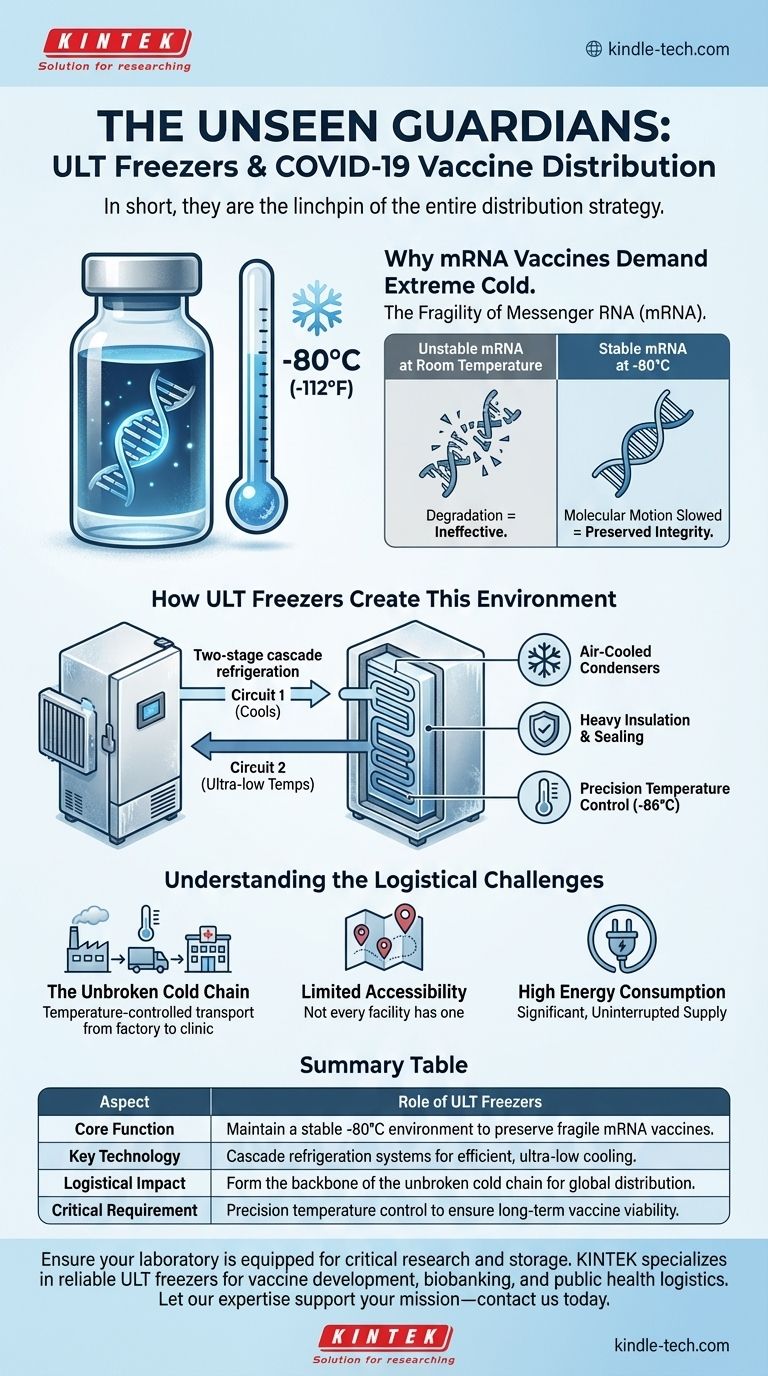
Related Products
- 108L Vertical Ultra Low Temperature ULT Freezer
- 708L Ultra Low Temperature Freezer High Performance Laboratory Freezer
- 208L Advanced Precision Laboratory Ultra Low Temperature Freezer for Cold Storage
- 608L Essential Laboratory Ultra Low Temperature Freezer For Critical Sample Preservation
- 808L Precision Laboratory Vertical Ultra Low Temperature Freezer
People Also Ask
- What advantages do ultra-low temperature freezers offer? Ensure Long-Term Sample Integrity and Reliability
- In what fields are ultra low temperature freezers most commonly used? Essential for Biomedical, Clinical, and Research Labs
- What are ultra low temperature freezers used for? Preserving Critical Biological Samples for Decades
- What factors should be considered when selecting an ultra-low temperature freezer? Ensure Sample Integrity and Long-Term Value
- What are the common designs of ultra-low temperature freezers? Upright vs. Chest Models for Your Lab














